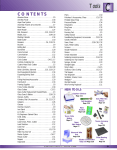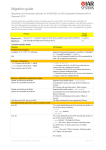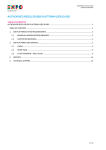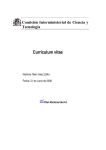Download TROUBLESHOOTING BASEL II: THE ISSUE OF
Transcript
TROUBLESHOOTING BASEL II: THE ISSUE OF PROCYCLICALITY Benyovszki Annamária Babeș-Bolyai University, Faculty of Economics and Business Administration Bordás Eszter Babeș-Bolyai University, Faculty of Economics and Business Administration Kürti László-Ádám Babeș-Bolyai University, Faculty of Economics and Business Administration Szodorai Melinda Babeș-Bolyai University, Faculty of Economics and Business Administration A widespread concern about Basel II capital requirements is that it might amplify business cycle fluctuations, forcing banks to restrict their lending when the economy goes into recession. Under the IRB approach of Basel II, capital requirements are increasing functions of the probability of default (PD), loss given default (LGD) and exposure at default (EAD) parameters estimated for each borrower, and these inputs are likely to rise in economic downturns. In this paper, we compare two alternative procedures that are designed to somehow moderate the procyclical effects induced by Basel II - type capital regulation. The starting points of our analysis consist Jokivuolla, Kiema and Vesala (2009) and Repullo and Suarez (2009), who both examined the impact of regulatory capital’s procyclical effects. It’s vital to note remarks of Caprio (2009), that is, making regulatory capital levels countercyclical could worsen the state of an economy during a recession. As we do not have access to the Romanian Central Credit Register database, we compute a model-economy that stands as a proxy for the Romanian firms’ sector. Our simulated Romanian economy can be characterised by all Romania-specific macroeconomic controls. Then we estimate a model of PDs during the period 2000 – 2010, and based on the estimated probabilities of default we compute the corresponding series of Basel II capital requirements. After the diagnosis of procyclicality, we analyze two procedures that try to mitigate the cyclical effects of capital regulation: smoothing the output of the Basel II formula, and smoothing the input, by construction of through-the-cycle (TTC) PDs. The comparison of the different procedures is based on the criterion of minimizing the root mean square deviations of each adjusted series. Our results show that the best ways to moderate procyclicality are either to smooth the input of the Basel II formula by using through-the-cycle PDs, or to smooth the output with a multiplier based on GDP growth. We conclude that the GDP-based smoothing may be more efficient than the use of TTC PDs in terms of simplicity and transparency. In terms of the GDP adjustment, regulatory capital levels should increase with approx. 1,31% during an economic growth period and decrease with 4,03% during a recession, in order to mitigate the cyclical effects induced by Basel II – type capital regulation. Keywords: Basel II, procyclicality, regulatory capital, probability of default, credit-crunch. JEL classification: G18, G17. I. Introduction The financial crisis proved that the capital requirements system, which is based on risk weights defined by Basel II, can’t adapt to the new economic prosperity. The recession is aggravated by the fact that the banks were forced to squeeze their credits and this caused a delay in the economy’s availability to grow. Several financial analysts pointed out the errors in the system, therefore the Basel Committee on Banking Supervision must find a solution in order to develop the model. 461 In our paper we compute an in-depth analysis on the issue of the procyclicality, comparing two possible methods that can be used to mitigate the cyclical effects of Basel II regulatory capital. The procyclical effect can be observed in historical data from the banking sector, since the capital regulation based on risk weights is very prosperity-sensitive: in recession the credit losses consume the bank’s capital, while venture capital increases. If banks aren’t able to gain enough capital for credit losses in a short period of time, then credit-crunch may occur. This kind of process characterizes perfectly the financial crisis. This leads to the fact that banks can’t even provide loans for customers with high ratings because of the inadequate level of capital. The structure of our paper is the following: in the first part we compute a brief review of the literature regarding the issue of procyclicality. This will be followed by an analysis regarding the methods of reducing the procyclical effects, by the use of a logistic model containing a onemonth-ahead probability of default (PD). Our goal is to find an answer to the fact that the cyclical effects can be effectively mitigated by fine-tuning of the PD indicators or by the change of the capital requirements. In the conclusion, we seek for other problems that arise when allocating regulatory capital. II. Literature Review We analyzed a series of different papers about procyclicality and its issues. Firstly we noticed that Jokivuolla, Kiema and Vesala (2009) and Repullo and Suarez (2009) both examined the impact of the regulatory capital’s procyclical effects. Contrary to Repullo and Suarez, Jokivuolla, Kiema and Vesala created a comparison between the regulatory capital requirements of the Basel I and Basel II. Their main question was that whether the risk-based or the constant weights-based regulatory capital requirement shows less procyclical impacts on the credit market. They used a simplified model, which interprets 3 types of market participants: low-risk profile investors, highrisk profile investors and risk-free investors. Their conclusion was that the optimal risk-based capital is the least procyclical. They added that the present Basel II’s necessary direction for further development is the implementation of a higher venture capital. Repullo and Suarez used a dynamic equilibrium model in which the banks can’t access stock markets in any period. Their conclusion was that, in the case of Basel II Capital Requirements, capital reserves constituted by banks are higher during an economic boom than during recessions. Secondly, we observed that Pederzoli, Toricelli and Tsomocos (2009) analyzed the problem of procyclicality with comparing two rating systems. They built up a general equilibrium model which contains 2 heterogeneous banks, 2 companies and 1 household. They found that the cyclical rating system results higher default rates and lower profit in the case of banks in recession times. Kashyap and Stein (2004) argue that if the shadow value of bank capital is low in expansions and high in recessions, optimal capital charges for each type of risk should depend on the state of the business cycle. Without such adjustments, capital requirements would be too low in expansions, when bank capital is relatively plentiful and has a low shadow value, and too high in recessions, when the shadow value of bank capital goes up, leading to the amplification of business cycle fluctuations. Greenspan (2002) noted that “the supervisory leg of Basel II is being structured to supplement market pressures in urging banks to build capital considerably over minimum levels in expansions as a buffer that can be drawn down in adversity and still maintain adequate capital.” Lastly, Caprio (2009) studied the counter-cyclical capital requirements definition and Repullo, Saurina and Trucharte (2010) analyzed and compared the procedures which mitigate the effects of the procyclical capital. The foundation of Caprio’s research was a macroeconomic data analysis from Spain and Columbia. His conclusion was that the risk-based capital regulatory system’s rectification results only short term adjustments. On the other side, Repullo, Saurina and Trucharte used data from Spanish companies and estimated a PD model. His results from this 462 research were very complex. Adjusting the output side of the Basel II formula with a credit growth multiplier or a yield multiplier, we don’t receive the optimal level of capital from the procyclical point of view. They found two possible solutions for handling the procyclicality: the first one is the input side smooth tuning, and the second one is on the output side, which can be received with the help of a multiplier based on GDP growth. III. Cyclical adjustments of Basel II capital requirements The recent financial crisis, with its boom and bust lending cycle, has brought to the forefront the need to address the potential procyclical effects of risk-sensitive bank capital regulation. To see how Basel II capital requirements evolve over the business cycle, we construct a model economy that is composed of one commercial bank and ten firms. The model is practically a simulation of the Romanian economy (also its banking and financial sector) over the period 2000-2010. The firms’ sector is composed of 2 corporate, 4 medium and 4 small companies, whose total exposures equal the aggregate credit portfolio to companies in the respective period. Our model economy is explicitly characterised by Romanian macroeconomic data regarding the specified period. To compute how regulatory capital levels would evolve over the business cycle, we estimate a logistic model of the one month ahead PDs of Romanian firms. The dependent variable, DEFAULTt is a binary variable that takes value 1 when a firm defaults in the course of a year on its outstanding loans at the end of the previous year, and zero otherwise. The explanatory variables comprise characteristics of the firm, characteristics of its loans, and macroeconomic variables. A borrower is considered to have defaulted if it is 90 days overdue failing to meet his financial obligations on a certain loan or if, with high probability, it is considered to be unable to meet its obligations. The explanatory variables used in the model (dated in month t) are firm-specific variables and Romanian macroeconomic controls. COLt represents the proportion of guarantees in a firm’s borrowing, proxying the amount of collateral. Jiménez, Salas and Saurina (2006) show that banks ask for collateral to those firms that they denote as being riskier. AGEt captures the age of each firm, with the idea that younger firms are more prone to default than older ones. FSIZEt proxies the size of a firm, it is calculated via deflating the EADt growth of a firm by the consumer price index; FSIZEt enters the model in logarithmic terms. HISTDEFt is considered to be the main risk profile variable that captures whether a certain borrower defaulted in the past. In each observed default event, the variable value is increased by 1. Similar to HISTDEFt, we use HISTDELt, that stands for the borrowers’ record of overdue loans (1). UTILt is the ratio between the amount of credit drawn by a borrower and the credit line. The macroeconomic explanatory variables are GDPt, that is the rate growth of the gross domestic product, CREDITt, the rate growth of non-financial (commercial and industrial) loans over the one month period, BETt, the monthly average return of the Romanian stock market, and MATURITYt, that is the ratio between long-term exposures (2) and the total exposures in the economy. Our database contains a total number of 126 monthly observations, over the last 10 years. Table 1 in the Appendix presents the results of the estimation of the model (all coefficients are statistically significant at the 10% level). It’s interesting to note that some variables’ impacts on the default condition (especially macroeconomic variables) are significant after up to 3 or 4 lags. The results show that firms that post collateral when granted a loan have higher probabilities of default. Also, firms whose exposures show a bigger growth rate than the average, have bigger probability of default. Yet vital to notice that the coefficients of GDP and MATURITY_4 are negative, meaning that as the growth rate of real GDP and proportion of long term exposures increase in the model economy, the PD decreases. The coefficient of variable UTIL_3 shows that the higher the utilization of credit lines the higher the PD, so liquidity constraints also seem to 463 play a role in a firm’s default. Summing up the analysis of the logit model, we can say that firm’s defaults increase during downturns and decrease during and economic upward trend. PIT capital requirements Based on the results in Table 1, we compute the point in time (PIT) capital requirements, kit, for each borrower and month using the formula , the estimated probability of default, PDt, and assuming a loss given default (LGD) of 45%, as in the foundation IRB approach of Basel II. The PIT capital requirements per unit of loans for each month is calculated via ∑ ∑ , where lit denotes the value of the loans to firm i at the end of the month t. Figure 1 shows how PIT capital requirements evolve among the GDP in the observed period. The cyclical effects can be easily captured by applying the Hodrick-Prescott(HP) trend to the series, with a lambda value of 500. Regarding the HP-smoothed PIT capital series, a significant cyclical variation can be observed, with a gap of 5.82% between the peak and the worst point of the business cycle. TTC capital requirements – Adjusting the input of Basel II formula A possible solution for mitigating the cyclical effects of regulatory capital is the use of through the cycle (TTC) capital requirements. To estimate DEFAULT by the TTC approach, we follow the idea of Saurina and Trucharte (2007), that is, replacing the current values of macroeconomic variables by their average values over the sample period. We then compute the monthly capital requirements with the Basel II foundation IRB approach. The results of the re-estimation of the logit model are found in Table 2. Comparing TTC capital requirements with the PIT values, the cyclical variability declines significantly, as it can be observed in Figure 2. The peak-low deviation in the TTC series is of 3.03%, significantly better then in the PIT capital requirements. The business cycle multiplier - Adjusting the output of the Basel II formula The second approach for adjusting the Basel II capital requirements is to smooth the output of the formula. Basically, we adjust the PIT-capital requirements series obtained from Table 1 with a business cycle multiplier, as it can be seen in the following formula: _ . The multiplier can be of various forms, but we use a simple and conventional approach: _ 2 ). ! In the equation kt denotes the original PIT capital series, and k_adjt the adjusted series. Regarding the multiplier equation, gt is the growth rate of one of the macroeconomic variables, g_avg its average over the sample period, hg its standard deviation over the sample period. N(x) is the standard normal cumulative distribution function and α is a positive constant parameter. The key features of the business cycle multiplier are: it is continuous and increasing in the proxy for the business cycle gt, so capital requirements are increased in favourable periods and lowered during downturns or recessions. Also, µ is bounded, so capital requirements do not increase without bound or become negative. Parameter α is defined as 0.1, however, we tested various other values. The purpose of α is to minimize the root mean square deviation (RMSD) of the adjusted series, and also to obtain a reasonable amount of capital adjustment. Summing up, we choose the value of α that is best in terms of smoothing the cyclical component of the pit capital requirements series. Figure 3 shows the µ-adjusted capital series (when g=GDP), together with 464 the PIT series. Note that the adjusted series has been applied a HP-filter of lambda=500, so that the cyclical-smoothing can be easily observed. IV. Results Taking into account the HP-filter fitted values, we compare the different smoothing procedures by computing the RMSD of each adjusted capital requirements series. The values obtained are shown in Table 3. The output-formula adjusted values show a much smaller deviation, as the TTC-series stands out with a RMSD of 0.16%. Regarding the output-smoothing procedure, a choice has to be made in order to specify the best smoothing macro-component. As the GDP and CREDIT deviations are more or less the same, we consider the amount of adjustment made during economic booms and downturns for the respective series. Results are shown in Table 4. In terms of the GDP adjustment, regulatory capital levels should increase with approx. 1.31% during an economic growth period and decrease with 4.03% during a recession. Having a look at the CREDIT-adjustment, results say that capital levels should increase with 0.86% in case of an upward trend and decrease with 0.88% in case of a downturn in the economy. As the CREDIT variable adjustment makes no significant (reasonable) changes regarding Basel II regulatory capital, we consider the output adjustment based on GDP growth to be the best smoothing procedure. As mentioned earlier, Figure 3 shows the GDP smoothed series together with the real GDP. Note that this result is not due to the fact that GDP growth is one of the explanatory variables in our logit model. V. Conclusions In this paper we focused on finding the optimal method for mitigating the procyclical effects of Basel II capital regulation. We analysed two major approaches regarding the issue, which is estimating TTC PDs, and fine-tuning the output of the Basel II formula. By building up a modeleconomy that simulates the Romanian banking and finance sector, we observed that a GDP growth based smoothing of Basel II capital requirements would be a good solution regarding the procyclicality issue. However, we emphasize that the TTC-approach should not be “written off”, as it is clearly a simple and effective way to make a quick and basic-level fine-tunement to regulatory capital levels. We stick to our statement knowing that the use of TTC PDs has been criticized by Gordy and Howells (2006), who underline the fact that changes in a bank’s capital requirements over time would be only weakly correlated with changes in its economic capital, and there would be no means to infer economic capital from regulatory capital. Our results are similar to those of Repullo, Saurina and Trucharte (2010) agreeing that GDP growth based output adjustment of the Basel II formula is the “way to go” in terms of simplicity, transparency, low cost of implementation and even consistency with the idea of a single aggregate risk factor that underlies the capital requirements of Basel II. Two major issues are still the purpose of our further research regarding Basel II. The first one, regulatory arbitrage, is mostly threatening safe and sound banking in the European Union, where its hazard is higher than in the countries outside the EU. To reduce this hazard, the specialists started to create a supervisory convergence. From this step, they expect that the discretionary assets will become reduced. The European Commission started a public consultation in 2010, in association with the fact that the 2009th Decree concerning the CRAs does not handle a lot of problems regarding the credit rating agencies. In this consultation document they discuss in detail the possible payment models and new measures, which prevent the potential risk of a rating arbitrage. The supervision of the rating agencies will be done by the European Securities and Markets Authority. The second, regarding the correct estimation of PD-LGD correlation, is a vital in building up a safe and sound banking system. The model standing behind the Basel II formula is the standard one factor model developed by Vasicek (1987). Many studies argue that this method cannot capture well the correlation between PD and LGD on a large (asymptotic) 465 portfolio. The innovative approach of Witzany (2009) proposes a two factor model. Results of testing the model prove that it is able to estimate more punctually and as realistic as possible the correlation between the two parameters, implemented on real banking data. The lack of reliable information however on public LGDs in the Romanian banking sector makes further research difficult. VI. Notes (1) Overdue loans are the ones that have been paid before the 90-day threshold. (2) Long term exposures are the ones that exhibit 5 years. VII. References 1.Caprio, Gerard. ”Safe and Sound Banking: A Role for Countercyclical Regulatory Requirements?”, “Paolo Baffi” Centre Research Paper Series No. 76(2010). 2.Gordy, Michael and Howells, Bradely. “Pro-cyclicality in Basel II: Can We Treat the Disease Without Killing the Patient?”. Journal of Financial Intermediation 15(2006):395-417. 3.Greenspan, Alan. “Cyclicality and Banking Regulation”, Conference on Bank Structure and Competition, Federal Reserve Bank of Chicago, May 10(2002). 4.Jimenez, Gabriel, Salas, Vicente and Saurina, Jesus. “Determinants of collateral”. Journal of Financial Economics 81 (2006): 255-291. 5.Jokivuolle, Esa, Kiema, Ilkka and Vesala, Timo. ”Credit allocation, capital requirements and procyclicality”. Bank of Finland Research Discussion Papers 23 (2009). 6.Kashyap, Anil and Stein, John. “Cyclical Implications of Basel II Capital Standards”. Federal Reserve Bank of Chicago, Economic Perspectives, 1st Quarter(2004):18-31. 7.Pederzoli, Chiara, Toricelli, Costanza and Tsomocos, Dimitrios. ”Rating systems, procyclicality, and Basel II: an evaluation in a general equilibrium framework”, Ann Finance (2009):33-49. 8.Repullo, Rafael and Suarez, Javier. ”The procyclical effects of bank capital regulation”. European Banking Center Discussion Paper No. 2010-05S, Center Discussion Paper No. 201029S (2009). 9.Repullo, Rafael, Saurina, Jesús and Trucharte, Carlos. ”Mitigating the pro-cyclicality of Basel II”. Documentos de Trabajo 1028 (2010). 10.Saurina, Jesus and Trucharte, Carlos. “An assessment of Basel II procylicality in mortgage portfolios”. Journal of Financial Services Research 32(1)(2007):81-101. 11.Vasicek, Oldrich. “Probability of loss on loan portfolio”. KMV Corporation 1987. 12Witzany, Jiri. “Estimating LGD correlation”. Working Paper Series IES 21 (2009). 466 VIII. Appendix Table 1: Initial estimation, PIT PDs Table 2: Adjusted estimation, TTC PDs Source: Authors’ calculations Source: Authors’ calculations Table 3: Results of output-adjustment Table 4: Overall Results Souce: Authors’ calculations Souce: Authors’ calculations Figure 1: PIT Capital Requirements Vs. GDP growth Source: Own calculations 467 Figure 2: PIT Capital Requirements Vs.TTC Capital Requirements and GDP growth Source: Own calculations Figure 3: GDP-adjusted Capital Requirements Vs. GDP growth Source: Own calculations 468





















